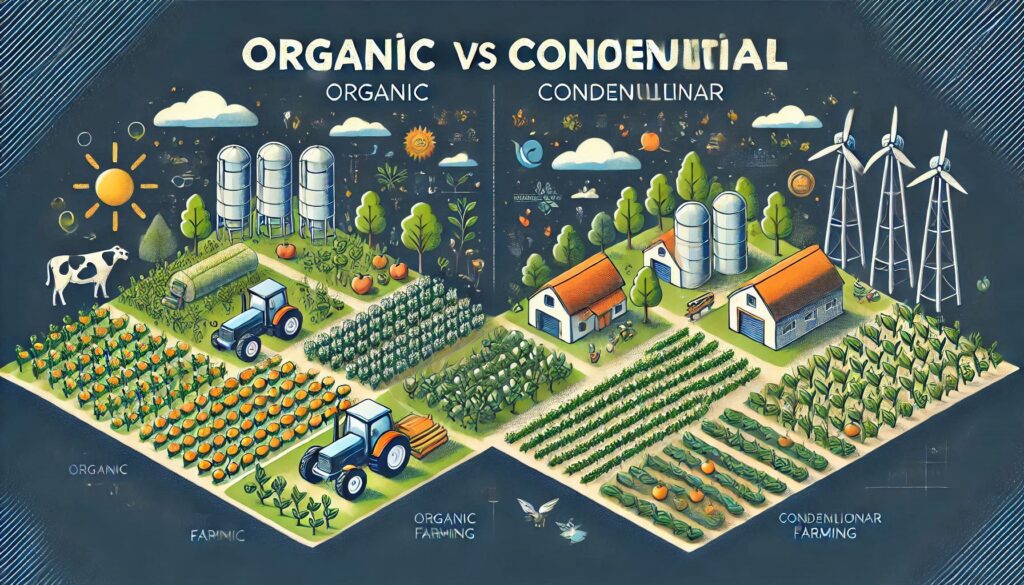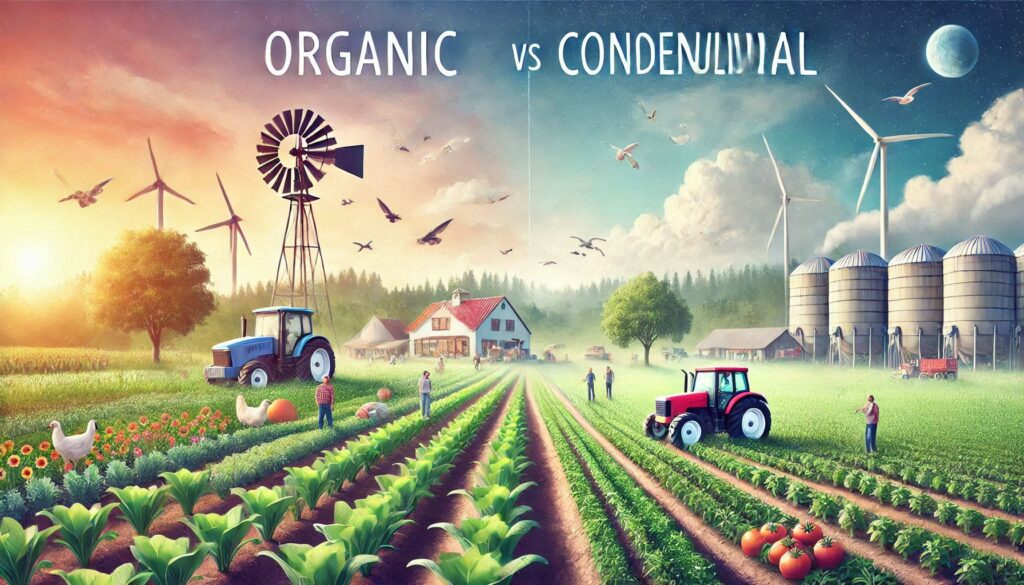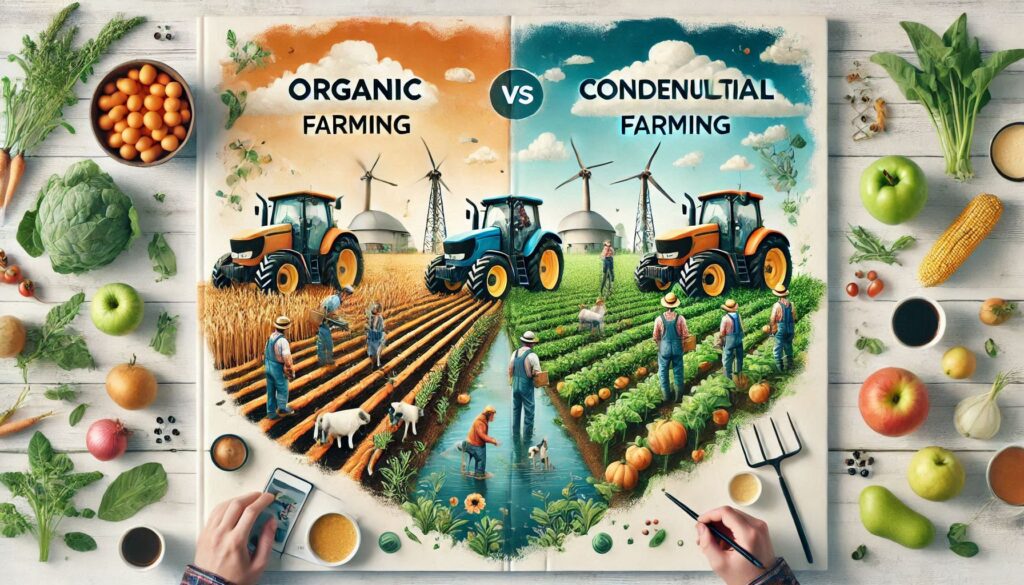
Farming is the backbone of global food production, but not all farming methods are created equal. Two dominant approaches—organic and conventional farming—differ significantly in their techniques, impacts, and philosophies. In this blog, we’ll dive into the key differences between organic and conventional farming, helping you understand their distinct practices and how they influence the environment, economy, and society.
What Is Organic Farming?
Organic farming is a sustainable agricultural method that relies on natural processes and materials to grow crops and raise livestock. It avoids synthetic chemicals, GMOs, and intensive farming practices, focusing instead on:
- Natural Inputs: Using compost, manure, and biological pest control.
- Soil Health: Maintaining soil fertility through crop rotation, cover cropping, and reduced tillage.
- Biodiversity: Encouraging diverse ecosystems within and around farms.
- Animal Welfare: Ensuring humane treatment and natural living conditions for livestock.
What Is Conventional Farming?
Conventional farming, also known as industrial or modern farming, prioritizes high yields and efficiency. It often employs synthetic fertilizers, pesticides, and genetically modified organisms (GMOs) to maximize production. Key features include:
- Synthetic Inputs: Reliance on chemical fertilizers and pesticides.
- Monoculture: Growing single crops on large tracts of land.
- Mechanization: Extensive use of machinery and advanced technologies.
- Intensive Livestock Farming: Confined animal feeding operations (CAFOs) to meet high demand.
Key Differences Between Organic and Conventional Farming

1. Soil Management
- Organic Farming: Focuses on enriching soil health through natural amendments like compost and green manure. Practices like crop rotation prevent nutrient depletion and erosion.
- Conventional Farming: Heavily relies on synthetic fertilizers to boost soil nutrients. However, prolonged use can degrade soil quality over time.
2. Pest and Weed Control
- Organic Farming: Uses natural methods such as companion planting, beneficial insects, and organic-approved pesticides.
- Conventional Farming: Relies on synthetic pesticides and herbicides, which may have long-term environmental and health impacts.
3. Crop Diversity
- Organic Farming: Encourages crop rotation and polyculture to maintain ecological balance and reduce disease risks.
- Conventional Farming: Often employs monoculture, which can increase vulnerability to pests and diseases.
4. Livestock Practices
- Organic Farming: Provides livestock with outdoor access, organic feed, and humane living conditions. Antibiotics are used only when absolutely necessary.
- Conventional Farming: Practices intensive animal farming with confined spaces, non-organic feed, and routine use of antibiotics and hormones.
5. Environmental Impact
- Organic Farming: Promotes sustainability by reducing pollution, conserving water, and enhancing biodiversity.
- Conventional Farming: Can contribute to soil degradation, water contamination, and loss of biodiversity due to synthetic inputs and intensive practices.
Economic and Social Implications
1. Costs and Profitability
- Organic Farming: Higher production costs due to labor-intensive practices, but organic products often fetch premium prices in the market.
- Conventional Farming: Lower production costs due to mechanization and synthetic inputs, but profitability may fluctuate with market prices.
2. Accessibility
- Organic Farming: Organic products can be expensive and less accessible, particularly in low-income communities.
- Conventional Farming: Provides affordable food at scale, making it accessible to a broader population.
3. Consumer Preferences
- Organic Farming: Appeals to consumers seeking chemical-free, environmentally friendly, and ethically produced food.
- Conventional Farming: Attracts those prioritizing affordability and convenience.

Health Impacts
1. Organic Farming
- Produces food free from synthetic chemicals and GMOs.
- Often associated with higher levels of nutrients and antioxidants.
- Reduces exposure to harmful pesticide residues.
2. Conventional Farming
- Relies on synthetic chemicals that can leave residues in food.
- May lead to potential health risks over long-term exposure to certain substances.
- Focuses on quantity rather than nutrient density.
Challenges and Opportunities
Challenges of Organic Farming
- Lower yields compared to conventional methods.
- Labor-intensive and time-consuming.
- Higher production costs.
Challenges of Conventional Farming
- Environmental degradation from chemical use.
- Overdependence on synthetic inputs.
- Ethical concerns around animal welfare and biodiversity loss.
Opportunities for Both
- Organic Farming: Growing consumer demand for sustainable and healthy food.
- Conventional Farming: Incorporating sustainable practices to reduce environmental impact while maintaining high yields.
Finding a Balance
The debate between organic and conventional farming doesn’t have to be polarizing. Many farmers adopt integrated approaches, combining the best practices of both methods to balance productivity and sustainability. Techniques like integrated pest management (IPM) and precision farming are examples of hybrid strategies.
Conclusion
Understanding the differences between organic and conventional farming helps consumers make informed choices. While organic farming prioritizes sustainability and health, conventional farming focuses on efficiency and scalability. By supporting practices that align with your values, you can contribute to a food system that benefits people and the planet.

Here are the top questions to ask people on organic farming, and related topics
- What is the primary difference in soil management between organic and conventional farming?
Organic farming enriches soil using compost, manure, and crop rotation. Conventional farming relies on synthetic fertilizers, which may degrade soil quality over time.
- How do organic and conventional farming differ in pest and weed control?
Organic farming uses natural methods like companion planting and biological pest control. Conventional farming relies on synthetic pesticides and herbicides, which can harm the environment
- What are the key differences in livestock practices?
Organic farming provides humane conditions, outdoor access, and organic feed. Conventional farming uses confined spaces, non-organic feed, and routine antibiotics.
- How do the environmental impacts of organic and conventional farming compare?
Organic farming promotes biodiversity, reduces pollution, and conserves water. Conventional farming can lead to soil degradation, water contamination, and biodiversity loss.
- What are the economic and accessibility differences between organic and conventional farming?
Organic farming has higher costs but yields premium prices. Conventional farming offers affordability and scalability but with fluctuating market profitability.


